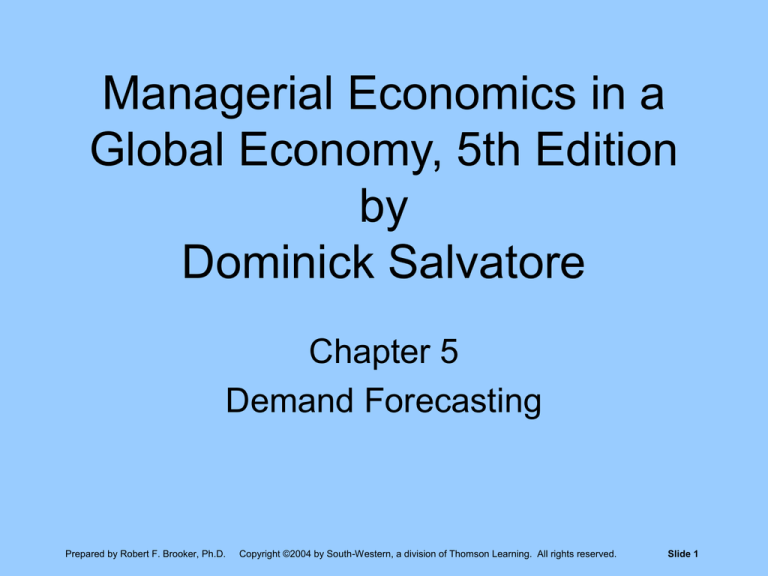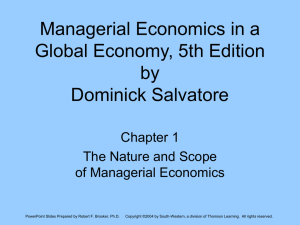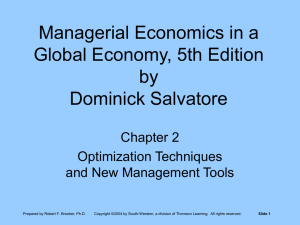
Managerial Economics in a
Global Economy, 5th Edition
by
Dominick Salvatore
Chapter 5
Demand Forecasting
Prepared by Robert F. Brooker, Ph.D.
Copyright ©2004 by South-Western, a division of Thomson Learning. All rights reserved.
Slide 1
Qualitative Forecasts
• Survey Techniques
– Planned Plant and Equipment Spending
– Expected Sales and Inventory Changes
– Consumers’ Expenditure Plans
• Opinion Polls
– Business Executives
– Sales Force
– Consumer Intentions
Prepared by Robert F. Brooker, Ph.D.
Copyright ©2004 by South-Western, a division of Thomson Learning. All rights reserved.
Slide 2
Time-Series Analysis
• Secular Trend
– Long-Run Increase or Decrease in Data
• Cyclical Fluctuations
– Long-Run Cycles of Expansion and
Contraction
• Seasonal Variation
– Regularly Occurring Fluctuations
• Irregular or Random Influences
Prepared by Robert F. Brooker, Ph.D.
Copyright ©2004 by South-Western, a division of Thomson Learning. All rights reserved.
Slide 3
Prepared by Robert F. Brooker, Ph.D.
Copyright ©2004 by South-Western, a division of Thomson Learning. All rights reserved.
Slide 4
Trend Projection
• Linear Trend:
St = S0 + b t
b = Growth per time period
• Constant Growth Rate
St = S0 (1 + g)t
g = Growth rate
• Estimation of Growth Rate
lnSt = lnS0 + t ln(1 + g)
Prepared by Robert F. Brooker, Ph.D.
Copyright ©2004 by South-Western, a division of Thomson Learning. All rights reserved.
Slide 5
Seasonal Variation
Ratio to Trend Method
Actual
Ratio =
Trend Forecast
Seasonal
Average of Ratios for
=
Adjustment
Each Seasonal Period
Adjusted
Forecast
Prepared by Robert F. Brooker, Ph.D.
Trend
= Forecast
Seasonal
Adjustment
Copyright ©2004 by South-Western, a division of Thomson Learning. All rights reserved.
Slide 6
Seasonal Variation
Ratio to Trend Method:
Example Calculation for Quarter 1
Trend Forecast for 1996.1 = 11.90 + (0.394)(17) = 18.60
Seasonally Adjusted Forecast for 1996.1 = (18.60)(0.8869) = 16.50
Year
1992.1
1993.1
1994.1
1995.1
Prepared by Robert F. Brooker, Ph.D.
Trend
Forecast
Actual
12.29
11.00
13.87
12.00
15.45
14.00
17.02
15.00
Seasonal Adjustment =
Ratio
0.8950
0.8652
0.9061
0.8813
0.8869
Copyright ©2004 by South-Western, a division of Thomson Learning. All rights reserved.
Slide 7
Moving Average Forecasts
Forecast is the average of data from w
periods prior to the forecast data point.
w
Ft
i 1
Prepared by Robert F. Brooker, Ph.D.
At i
w
Copyright ©2004 by South-Western, a division of Thomson Learning. All rights reserved.
Slide 8
Exponential Smoothing
Forecasts
Forecast is the weighted average of of
the forecast and the actual value from
the prior period.
Ft 1 wAt (1 w) Ft
0 w 1
Prepared by Robert F. Brooker, Ph.D.
Copyright ©2004 by South-Western, a division of Thomson Learning. All rights reserved.
Slide 9
Root Mean Square Error
Measures the Accuracy
of a Forecasting Method
RMSE
Prepared by Robert F. Brooker, Ph.D.
(A F )
t
2
t
n
Copyright ©2004 by South-Western, a division of Thomson Learning. All rights reserved.
Slide 10
Barometric Methods
•
•
•
•
•
•
•
National Bureau of Economic Research
Department of Commerce
Leading Indicators
Lagging Indicators
Coincident Indicators
Composite Index
Diffusion Index
Prepared by Robert F. Brooker, Ph.D.
Copyright ©2004 by South-Western, a division of Thomson Learning. All rights reserved.
Slide 11
Econometric Models
Single Equation Model of the
Demand For Cereal (Good X)
QX = a0 + a1PX + a2Y + a3N + a4PS + a5PC + a6A + e
QX = Quantity of X
PS = Price of Muffins
PX = Price of Good X
PC = Price of Milk
Y = Consumer Income
A = Advertising
N = Size of Population
e = Random Error
Prepared by Robert F. Brooker, Ph.D.
Copyright ©2004 by South-Western, a division of Thomson Learning. All rights reserved.
Slide 12
Econometric Models
Multiple Equation Model of GNP
Ct a1 b1GNPt u1t
I t a2 b2 t 1 u2t
GNPt Ct It Gt
Reduced Form Equation
Gt
a1 a2 b2 t 1
GNPt
Prepared by Robert F. Brooker, Ph.D.
1 b1
1
b1
1 b1
Copyright ©2004 by South-Western, a division of Thomson Learning. All rights reserved.
Slide 13
Input-Output Forecasting
Three-Sector Input-Output Flow Table
Producing Industry
Supplying
Industry
A
B
C
Value Added
Total
Prepared by Robert F. Brooker, Ph.D.
A
20
80
40
60
200
B
60
90
30
120
300
C
30
20
10
40
100
Final
Demand
90
110
20
Total
200
300
100
220
220
Copyright ©2004 by South-Western, a division of Thomson Learning. All rights reserved.
Slide 14
Input-Output Forecasting
Direct Requirements Matrix
Direct
Requirements
=
Input Requirements
Column Total
Producing Industry
Supplying
Industry
A
B
C
Prepared by Robert F. Brooker, Ph.D.
A
0.1
0.4
0.2
B
0.2
0.3
0.1
C
0.3
0.2
0.1
Copyright ©2004 by South-Western, a division of Thomson Learning. All rights reserved.
Slide 15
Input-Output Forecasting
Total Requirements Matrix
Producing Industry
Supplying
Industry
A
B
C
Prepared by Robert F. Brooker, Ph.D.
A
1.47
0.96
0.43
B
0.51
1.81
0.31
C
0.60
0.72
1.33
Copyright ©2004 by South-Western, a division of Thomson Learning. All rights reserved.
Slide 16
Input-Output Forecasting
Total
Requirements
Matrix
1.47
0.96
0.43
Prepared by Robert F. Brooker, Ph.D.
0.51
1.81
0.31
0.60
0.72
1.33
Final
Total
Demand Demand
Vector
Vector
90
110
20
=
200
300
100
Copyright ©2004 by South-Western, a division of Thomson Learning. All rights reserved.
Slide 17
Input-Output Forecasting
Revised Input-Output Flow Table
Producing Industry
Supplying
Industry
A
B
C
Prepared by Robert F. Brooker, Ph.D.
A
22
88
43
B
62
93
31
C
31
21
10
Final
Demand
100
110
20
Total
215
310
104
Copyright ©2004 by South-Western, a division of Thomson Learning. All rights reserved.
Slide 18








